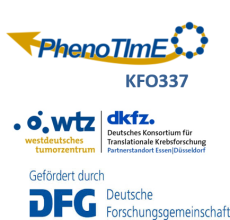PhenoTImE: PhD Project #4
Description Project #4 Defining the role of CIITA in tumor cell-intrinsic and CD4+ T cell-induced phenotype switching and therapy resistance
CIITA is the master regulator of a gene network involved in HLA class II (HLA-II) antigen presentation to CD4+ T cells. Professional antigen presenting cells (pAPCs) constitutively express CIITA (constCIITA) while in other cells CIITA is induced by IFNg via the JAK-STAT signaling pathway. Interestingly, a subgroup of melanoma cells shows JAK-STAT-independent constCIITA/HLA-II expression similar to pAPCs. The mechanisms leading to the establishment of a constCIITA/HLA-II tumor cell phenotype are poorly understood. In general, tumor cell-intrinsic constCIITA expression is considered anti-tumorigenic due to the constCIITA/HLA II-dependent activation of tumor antigen-specific CD4+ T cells and consequently the release of anti-proliferative pro-inflammatory T cell cytokines (IFNg,TNFα). In contrast, our preliminary work points to a so far undescribed pro-tumorigenic activity of tumor cell-intrinsic constCIITA. Our data suggest that a constCIITA-driven gene network enhances melanoma cell invasion and therapy resistance. Moreover, we find constCIITA expression in melanoma cells associated with a more de-differentiated phenotype. Hence, we hypothesize in this proposal that melanoma cell-intrinsic constCIITA controls a gene network with pro-tumorigenic activity enhancing tumor cell invasiveness, therapy resistance, and phenotype switching. Moreover we hypothesize that phenotype switching is further enhanced by the constCIITA-mediated ‘tumor-immune circuitry’ via pro-inflammatory T cell cytokines. The collaborations within the Clinical Research Unit PhenoTImE provide a unique platform that will allow us to elucidate (i) the mechanisms inducing constCIITA in melanoma, (ii) the constCIITA-driven gene network and its pro-tumorigenic activity, (iii) the role of the constCIITA/HLA-II melanoma phenotype in driving adaptive therapy-resistant cell state transition of surrounding cells by activation of cytokine release from CD4+ T cells. Targeting the constCIITA-driven gene network could represent a superior way of overcoming therapy and immune resistance in melanoma. This has immediate implications for the design of personalized clinical trials and could lead to the development of new biomarkers and companion diagnostics in the near future.
Project-related publications of the Paschen lab (selection)
Pieper N, Zaremba A, Leonardelli S, Noelle Harbers F, Schwamborn M, Lübcke S, Schrörs B, Baingo J, Schramm A, Haferkamp S, Seifert U, Sucker A, Lennerz V, Wölfel T, Schadendorf D, Schilling B, Paschen A, Zhao F. Evolution of melanoma cross-resistance to CD8+ T cells and MAPK inhibition in the course of BRAFi treatment. Oncoimmunol. 2018;7:e1450127.
Sucker A, Zhao F, Block N, Heeke C, Maltaner R, Stadler N, Real B, Bielefeld N, Howe S, Weide B, Gutzmer R, Utikal J, Loquai C, Gogas H, Klein-Hitpass L, Zeschnigk M, Westendorf AM, Trilling M, Horn S, Schilling B, Schadendorf D, Griewank KG, Paschen A. Acquired IFNγ resistance impairs anti-tumor immunity and gives rise to T cell-resistant melanoma lesions. Nat Commun. 2017;8:15440.
Roesch A, Paschen A, Landsberg J, Helfrich I, Becker JC, Schadendorf D. Phenotypic tumour cell plasticity as a resistance mechanism and therapeutic target in melanoma. Eur J Cancer. 2016;59:109-12.
Zhao F, Sucker A, Horn S, Heeke C, Bielefeld N, Schrörs B, Bicker A, Lindemann M, Roesch A, Gaudernack G, Stiller M, Becker JC, Lennerz V, Wölfel T, Schadendorf D, Griewank K, Paschen A. Melanoma Lesions Independently Acquire T-cell Resistance during Metastatic Latency. Cancer Res. 2016;76:4347-58
Candidate Qualifications and Assignments
Candidate’s profile:
- Master’s degree in any of the following or equivalent disciplines: Medical Sciences, Biology, Molecular Biology, Immunology, Cell Biology
- Practical expertise in cellular and molecular biology standard methods (e.g. qPCR, WB, cell staining, flow cytometry)
Project tasks & Training:
- Isolation of melanoma cell subpopulations and genotype/phenotype analyses (exome/ transcriptome analyses, flow cytometry, WB)
- functional cell assays (e.g. real-time proliferation/invasion on xCELLigence platform, cell viability assays )
- Gene knockout (CRISPR/Cas9) and gene labeling (CRISPaint)
- Chromatin immunoprecipitation (CHIP) and CHIPSeq
- Tumor – immune cell cocultures
- T cell activation assays (ELISA, ELISpot, intracellular cytokine staining)
- Drug testing in 2D and 3D cell culture models, in vivo
- Validation of research findings in situ by multiplexed staining (human tissue samples)
- Experiment planning, implementation, and subsequent evaluation
- Presenting the work at national and international conferences and scientific writing of papers
- Active collaboration with other researchers within the Clinical Research Unit



